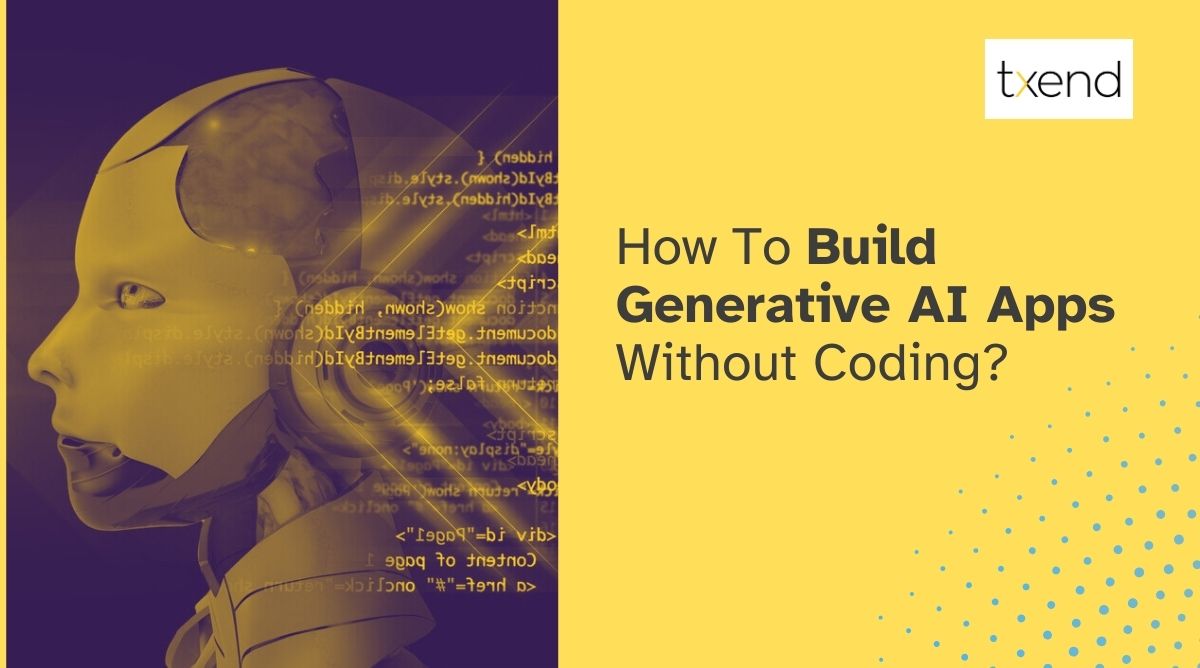
Are you fascinated by the rapidly evolving landscape of generative AI applications? Do you dream of creating cutting-edge AI-driven applications, but coding has always felt like a daunting hurdle? If so, you’re in the right place.
In this article, we’ll take you on a journey through the exciting world of generative AI app development. We’ll explore the top generative AI tools and techniques that empower you, as an AI app developer, to bring your ideas to life without the need for extensive coding skills. So, fasten your seatbelt and get ready to dive into the realm of the Generative AI App Builder, where innovation and creativity intersect effortlessly with technology.
Key Takeaways
- Trends include enhanced customization, simplified UI/UX, and seamless integration, catering to diverse user preferences and business requirements.
- Generative AI app builders use deep learning models to create customized apps, leveraging user inputs and predefined templates for development.
- Benefits comprise rapid app development, cost-effectiveness, tailored user experiences, and simplified coding, enabling efficient app creation and deployment.
- Types include model-based, text-to-app, and image-to-app builders, each utilizing specific data inputs and algorithms for app generation.
Trends in Generative Artificial Intelligence App Builder
A Generative artificial intelligence app builder refers to a software or platform that enables the creation of sophisticated AI applications without the necessity for extensive coding knowledge. These tools leverage the power of generative AI algorithms to allow developers and non-technical individuals to create complex and innovative applications that can generate content, images, or even entire software solutions autonomously.
Now, let’s explore the current trends surrounding Generative artificial intelligence app builders in the United States.
The generative AI app builder landscape in the US is witnessing a surge in innovation and adoption, with several notable trends shaping the industry. Firstly, there’s a growing emphasis on user-friendly interfaces, allowing even those without extensive technical expertise to leverage the power of generative AI. Many of these platforms are integrating intuitive drag-and-drop features, simplifying the app development process significantly.
Secondly, the integration of advanced machine learning models within these app builders is revolutionizing the capabilities of AI applications. These models are enabling the development of highly personalized and adaptive solutions that can cater to a diverse range of user preferences and requirements.
Furthermore, there’s a notable shift towards collaborative development environments within these app builders, fostering teamwork and collective creativity. Developers can now seamlessly collaborate, share insights, and collectively work on complex AI projects, leading to the creation of more robust and innovative applications.
Additionally, the focus on comprehensive documentation and extensive support services within these platforms is ensuring that developers have access to the necessary resources and guidance required to maximize the potential of generative AI app building.
In essence, the Generative artificial intelligence app builder trends in the US signify a pivotal shift towards democratizing AI development, making it more accessible and inclusive for a broader spectrum of developers and businesses, ultimately driving innovation and creativity in the field.
How does a generative AI app builder work?
A Generative artificial intelligence app builder operates through a combination of advanced algorithms and user-friendly interfaces, simplifying the intricate process of AI app development for both seasoned developers and individuals with limited coding experience.
Typically, these platforms follow a series of key steps to facilitate the creation of sophisticated AI applications:
Data Input and Analysis
As the basis for the AI model, the process often starts with the entry of pertinent data. This data can include various forms of content, such as text, images, or even audio files, depending on the nature of the application being built. The app builder then analyzes this data to identify patterns and extract meaningful insights.
Algorithm Selection and Configuration
After the data analysis, the platform allows users to select and configure specific generative AI algorithms that align with the desired functionalities of the application. These algorithms can range from natural language processing (NLP) models for text generation to deep learning frameworks for image synthesis, depending on the intended application’s requirements.
Model Training and Optimization
Once the algorithms are in place, the app builder initiates the training process, where the selected AI model learns from the provided data to improve its performance and predictive capabilities. During this phase, the platform may offer optimization tools to refine the model’s accuracy and efficiency, ensuring that it can generate high-quality outputs consistently.
User Interface Design and Customization
To enable a seamless user experience, generative AI app builders often provide intuitive interfaces that allow users to design and customize the application’s interface without delving into complex coding structures. This feature enables developers to create visually appealing and user-friendly applications tailored to specific user preferences and requirements.
Output Generation and Application Deployment
Upon completion of the development process, the app builder generates the final outputs, which can include text, images, or entire application prototypes, depending on the intended use case. Users can then deploy these applications across various platforms, such as web browsers, mobile devices, or specific operating systems, making them accessible to a broader audience.
All things considered, a Generative artificial intelligence app builder simplifies the development process by fusing complex AI capabilities with approachable features, enabling developers to produce cutting-edge AI applications without requiring a great deal of coding knowledge.
Benefits of using a generative AI app builder
Utilizing a Generative artificial intelligence app builder in the United States offers a multitude of benefits, fostering innovation, efficiency, and accessibility within the realm of AI app development.
Here are some of the key advantages:
Simplified Development Process:
Generative AI app builders streamline the traditionally complex development process, enabling both experienced developers and newcomers to create sophisticated AI applications without extensive coding knowledge. This accessibility encourages a broader pool of individuals to engage in AI app development, fostering a more inclusive and diverse tech community.
Time and Cost Efficiency:
By eliminating the need for intricate coding, these app builders significantly reduce the time and resources required for app development. This efficiency translates into cost savings for businesses and developers, allowing them to allocate their resources towards other critical aspects of innovation and growth.
Enhanced Creativity and Innovation:
With intuitive interfaces and a diverse range of AI tools at their disposal, developers can unleash their creativity and explore innovative ideas more freely. The flexibility provided by Generative artificial intelligence app builders empowers developers to experiment with various AI models and functionalities, leading to the creation of novel and groundbreaking applications.
Access to Advanced AI Capabilities:
These app builders often integrate state-of-the-art AI algorithms and tools, providing users with access to advanced capabilities such as natural language processing, image generation, and predictive modeling. This access allows developers to leverage cutting-edge technologies and incorporate advanced AI functionalities into their applications without the need for specialized expertise.
Faster Prototyping and Iteration:
Generative AI app builders facilitate rapid prototyping and iterative development, enabling developers to test and refine their applications quickly. This agile development process encourages continuous improvement and refinement, ensuring that the final applications meet the evolving demands and expectations of users and the market.
Democratization of AI Development:
By simplifying the development process, these app builders contribute to the democratization of AI development, making it more accessible to a broader audience. This inclusivity fosters a collaborative and diverse environment, encouraging individuals from various backgrounds to participate in the creation of innovative AI applications, ultimately driving the advancement of the tech industry as a whole.
In essence, leveraging a Generative artificial intelligence app builder in the US empowers developers to overcome technical barriers, embrace creativity, and harness the transformative potential of AI, leading to the development of groundbreaking applications that cater to diverse user needs and preferences.
Different types of generative AI app builders
Generative artificial intelligence app builders come in various forms, each tailored to specific user requirements and technical capabilities. Here are some of the different types of Generative artificial intelligence app builders, along with examples illustrating their functionalities:
Drag-and-Drop Interface Builders:
With the help of these app builders’ intuitive UI, developers can design AI apps by just dragging and dropping components into a visual canvas.
One such example is Bubble, which enables users to build web applications visually without the need for coding. With Bubble, developers can integrate generative AI functionalities seamlessly into their applications, simplifying the development process significantly.
Template-Based Builders:
These platforms offer a selection of pre-made layouts and templates that developers may alter to quickly create AI apps.
One notable example is Wix, a popular website builder that offers AI-powered design tools, enabling users to create visually appealing websites with AI-generated content and personalized user experiences, all without extensive coding knowledge.
Integrated Development Environments (IDEs):
With the help of these all-inclusive platforms’ many tools and functionalities, developers can design, test, and implement sophisticated AI applications all from one interface.
The open-source machine learning platform TensorFlow provides a comprehensive set of tools for building and optimizing artificial intelligence models. It’s a perfect illustration. TensorFlow’s rich set of libraries and resources facilitate the development of advanced generative AI applications for various use cases.
AI-Enabled Frameworks:
These frameworks integrate AI capabilities directly into the development process, allowing developers to leverage advanced AI functionalities without the need for in-depth AI expertise.
PyTorch is an excellent example of such a framework, providing a flexible and user-friendly platform for building deep learning models and implementing advanced generative AI techniques. The comprehensive documentation and user-friendly interface of this platform make it the perfect option for developers wishing to smoothly integrate generative AI functions into their apps.
Cloud-Based AI Platforms:
These platforms provide cloud-based tools and services that let developers create and run AI apps without requiring a lot of hardware.
Google Cloud AI Platform is a prime example of a cloud-based AI platform that provides a range of AI tools and services, including pre-trained models and custom model training capabilities. With Google Cloud AI Platform, developers can leverage the power of cloud computing to create and deploy scalable generative AI applications efficiently.
Developers can select the best platform based on their technical expertise and project requirements by learning about the various kinds of Generative artificial intelligence app builders and investigating their features. This will enable the smooth creation of creative and potent AI applications.
Features to look for in a generative AI app builder
There are a few key components to look for in a Generative artificial intelligence app builder that can greatly improve the development process and make it possible to create complex AI apps without needing to know a lot of code. Check for the following important characteristics:
User-Friendly Interface:
A user-friendly interface is crucial for simplifying the app development process, allowing developers to navigate the platform effortlessly and create applications intuitively, without the need for complex coding.
Drag-and-Drop Functionality:
Look for platforms that offer a drag-and-drop functionality, enabling users to easily integrate various components and features into their applications, streamlining the development process and fostering a more efficient workflow.
AI Model Libraries:
A robust AI model library provides access to a diverse range of pre-trained models and algorithms, empowering developers to leverage advanced AI capabilities without the need for extensive AI expertise, ultimately enabling the creation of more sophisticated and innovative AI applications.
Customization Options:
The ability to customize AI models and application interfaces according to specific project requirements is crucial. Look for app builders that offer a high degree of customization, allowing developers to tailor their applications to meet the unique needs and preferences of their target audience.
Documentation and Support:
Comprehensive documentation and robust support services are vital for developers, particularly those new to AI app development. Look for platforms that provide extensive documentation, tutorials, and a responsive support system to assist developers in navigating the app builder and addressing any technical challenges they may encounter.
Integration Capabilities:
Consider app builders that offer seamless integration with third-party services and tools, allowing developers to incorporate additional functionalities and enhance the overall capabilities of their AI applications, ultimately enabling a more comprehensive and versatile user experience.
Scalability and Performance:
An ideal generative AI app builder should offer scalability and high performance, enabling developers to create applications that can handle complex tasks and process large volumes of data efficiently, ensuring a seamless user experience even as the application’s user base grows.
Data Security and Compliance:
Given the sensitive nature of data used in AI applications, prioritizing data security and compliance is crucial. To secure user data and privacy, look for app builders who adhere to industry standards and regulations and prioritize strong data security methods.
Developers can choose a platform that best suits their particular project requirements by taking these important factors into account while assessing Generative artificial intelligence app builders. This will help them make well-informed selections and produce inventive and potent AI applications quickly and effectively.
How to choose the right generative AI app builder for your needs?
Assess Your Requirements:
Begin by assessing your project requirements and the specific features you need in an AI app builder. Consider factors such as the complexity of the application you intend to build, the level of customization you require, and the scalability you anticipate for your application.
Research Different Platforms:
Conduct thorough research on different Generative artificial intelligence app builders available in the market. Look for platforms that align with your project requirements and offer the specific features and functionalities you identified in the initial assessment.
Evaluate User-Friendly Interfaces:
Select a platform that makes the development process easier with an intuitive and user-friendly interface. Ensure that the platform’s interface allows for easy navigation and seamless integration of various components and features, facilitating a smooth and efficient development workflow.
Check for Customization Options:
Choose an AI app builder that offers you a wide range of modification options so you may adjust the UI, features, and AI models of the application to your target audience’s unique requirements. Look for platforms that offer a high degree of flexibility in customization without compromising the overall user experience.
Review AI Model Libraries:
Look for app builders that offer comprehensive AI model libraries, providing access to a diverse range of pre-trained models and algorithms. Evaluate the platform’s AI capabilities and ensure that it aligns with the specific AI functionalities you intend to incorporate into your application.
Consider Integration Capabilities:
Select a platform that offers seamless integration with third-party services and tools, allowing you to enhance the application’s functionalities and capabilities. Ensure that the platform supports easy integration with external APIs and services, enabling you to expand the application’s features and functionalities as needed.
Assess Documentation and Support:
Prioritize platforms that offer comprehensive documentation, tutorials, and responsive support services. Evaluate the platform’s resources and support system to ensure that you have access to the necessary guidance and assistance throughout the development process, especially if you are new to AI app development.
Prioritize Data Security and Compliance:
Select an app developer who adheres to industry norms and regulations and places a high priority on effective data security measures. Ensure that the platform adheres to data security best practices to safeguard user data and privacy, mitigating potential risks associated with data breaches and unauthorized access.
With the help of these processes, you can efficiently assess and select the best Generative artificial intelligence app builder for your project, enabling you to develop complex AI applications without requiring a lot of coding knowledge.
How to get started with a generative AI app builder?
here is a step-by-step guide on how to get started with a Generative artificial intelligence app builder in the US:
Research and Familiarize Yourself with Generative AI:
Begin by conducting comprehensive research on the fundamentals of generative AI and its applications. Familiarize yourself with the various types of Generative artificial intelligence app builders available in the market and their specific features and functionalities.
Identify Your Project Requirements:
Determine the specific requirements of your AI application project. Identify the scope of your project, the target audience, and the desired functionalities you intend to incorporate into your application. This step will help you choose the most suitable Generative artificial intelligence app builder that aligns with your project goals.
Select a Suitable Generative AI App Builder:
Evaluate different Generative artificial intelligence app builders based on your project requirements and chosen keywords. Consider factors such as the platform’s user interface, available AI model libraries, customization options, integration capabilities, and support services. Select a platform that best fits the requirements of your project and your level of technical proficiency.
Sign up and Create an Account:
Visit the website of the selected Generative artificial intelligence app builder and sign up for an account. Follow the registration process and provide the necessary information to create your account. To ensure a seamless onboarding process, make sure you have access to the platform’s documentation and support resources.
Explore Tutorials and Documentation:
Familiarize yourself with the platform’s tutorials and documentation to gain a better understanding of the app builder’s functionalities and features. Explore the available resources, including video tutorials, user guides, and FAQs, to learn how to navigate the platform and utilize its tools effectively.
Begin with Simple Projects:
Start with simple AI application projects to familiarize yourself with the platform’s interface and features. Experiment with the available templates and pre-built models to understand how they function and how you can customize them according to your project requirements. Use this opportunity to explore the platform’s drag-and-drop functionalities and customization options.
Join Community Forums and Discussion Groups:
Engage with the platform’s community forums and discussion groups to connect with other AI app developers and users. Engage in dialogues, pose inquiries, and share your experiences to obtain insightful advice and direction from seasoned users and business experts.
Attend Webinars and Workshops:
Attend webinars, workshops, and training sessions offered by the platform to enhance your understanding of generative AI app development. Utilize the platform’s educational resources to broaden your knowledge and keep up with the most recent advancements and trends in the field of generative artificial intelligence.
By following these steps, you can effectively kickstart your journey with a Generative artificial intelligence app builder in the US, enabling you to create innovative and sophisticated AI applications without the need for extensive coding expertise.
Examples of generative AI apps
Here are some examples of generative AI apps that have made an impact in various fields:
Artbreeder:
With the help of complex AI algorithms, users of the well-known generative AI app Artbreeder may combine and evolve photos to produce original, eye-catching artwork. Users can manipulate various artistic elements, such as color, texture, and style, to generate new and original artworks, offering a novel way for artists and enthusiasts to explore their creativity.
DALL-E:
Developed by OpenAI, DALL-E is an advanced generative AI app that can create images from textual descriptions. Users can input specific prompts or descriptions, and DALL-E generates corresponding images that align with the provided textual input, showcasing the potential of AI in producing visual content based on textual cues.
DeepArt:
DeepArt is a generative AI app that enables users to transform their photos into artworks inspired by famous artists and art styles. Users may create unique and eye-catching artworks that emulate the styles of well-known artists like Van Gogh, Picasso, and many more by applying a variety of artistic filters and styles to their photographs.
RunwayML:
RunwayML is a versatile generative AI app that offers a range of tools and models for creating AI-powered projects across various domains, including art, design, and media. It offers consumers with an extensive selection of AI models, enabling them to explore different AI tactics and generate imaginative works without necessitating a profound comprehension of coding.
Wordsmith:
Wordsmith is an AI-powered natural language generation platform that allows users to generate human-like text content automatically. This generative AI app is widely used in the field of content creation, enabling users to produce personalized and engaging written content for various applications, including marketing campaigns, personalized product descriptions, and more.
These examples demonstrate the diverse applications of generative AI in various fields, showcasing how AI-powered tools and platforms have revolutionized the creative process and enabled users to generate unique and personalized content without the need for extensive coding expertise.
3 Case studies of businesses using generative AI apps
Here are three case studies of businesses in the USA that have successfully leveraged generative AI apps:
Adobe and Project Scribbler:
Adobe, a prominent software company, integrated generative AI capabilities into their design tools through Project Scribbler. This initiative aimed to assist graphic designers in creating unique and innovative designs more efficiently.
Project Scribbler utilized generative AI algorithms to generate design suggestions and refine artwork, enabling designers to explore creative possibilities and streamline their design process.
By incorporating generative AI tools, Adobe enhanced the efficiency and creativity of their design software, empowering designers to produce visually appealing and dynamic content effortlessly.
Primer and Natural Language Processing:
Primer, a natural language processing company, utilized generative AI apps to streamline and automate the process of analyzing large volumes of text data.
By leveraging advanced natural language processing algorithms, Primer developed AI-driven solutions that could extract insights from complex textual data, enabling businesses to make informed decisions and derive actionable intelligence from extensive datasets.
Primer’s generative AI apps revolutionized the way businesses approached data analysis and interpretation, facilitating more efficient and accurate decision-making processes.
Salesforce and Einstein AI:
With Einstein AI, Salesforce, a well-known customer relationship management (CRM) platform, has added generative AI capabilities to its offerings. Salesforce improved customer interactions, automated repetitive activities, and gave users personalized suggestions based on their likes and actions by utilizing generative AI software.
By leveraging Einstein AI, Salesforce empowered businesses to deliver exceptional customer experiences, improve sales strategies, and optimize marketing campaigns, thereby fostering stronger customer relationships and driving business growth.
These case studies highlight how businesses in the USA have successfully implemented generative AI apps to streamline operations, enhance decision-making processes, and improve customer experiences, demonstrating the transformative impact of generative AI technology across various industries.
Tips for building successful generative AI apps
Here are some tips for building successful generative AI apps in the USA:
Define a Clear Purpose:
Before you start building a generative AI app, it’s essential to define a clear and specific purpose for your application. Understand the problem you aim to solve or the value you intend to deliver to your target users. A well-defined purpose will guide your development process and help you stay focused on your app’s goals.
Know Your Audience:
Understand your target audience and their needs. Identify the user personas and preferences that your generative AI app will cater to. Knowing your audience is crucial for designing a user-centric application that meets their expectations and adds value to their lives.
Choose the Right Generative AI App Builder:
Select a Generative artificial intelligence app builder that aligns with your project requirements and technical expertise. Look for a platform that offers the features and functionalities you need, such as a user-friendly interface, customization options, and support for the specific AI models your app will rely on.
Data Quality and Quantity:
High-quality and sufficient data is the foundation of generative AI. Ensure that you have access to relevant and well-labeled data for training your AI models. The accuracy and functionality of your generative AI program are highly dependent on the type and volume of data.
Understand Ethical Considerations:
Generative AI apps should be developed and used responsibly. Be aware of ethical considerations, privacy concerns, and potential biases in your AI models. Strive to maintain transparency in how the AI-generated content is created and ensure user data is handled with care.
Iterative Development:
Embrace an iterative development approach. Your generative AI software should begin with a minimum viable product (MVP) and evolve periodically in accordance with feedback from users and shifting requirements. Regularly test and iterate to improve the app’s performance and user experience.
User Interface Design:
Observe how the user interface (UI) is designed. To engage users and reach a larger audience with your generative AI software, you must have a simple and user-friendly UI. Consider the aesthetics, layout, and usability of your app.
Testing and Validation:
Rigorous testing and validation are crucial. Ensure that your generative AI app functions as expected, generates accurate content, and meets the quality standards you’ve set. Test for various scenarios and user interactions to identify and rectify any issues.
User Education and Support:
Provide educational resources and user support within your app. Users may not be familiar with generative AI technology, so offering guidance and assistance can enhance their experience and help them make the most of the app’s capabilities.
Compliance and Regulations:
Recognize any legal or regulatory requirements, such as those pertaining to data protection and intellectual property rights, that might apply to your generative AI app. Ensure your app complies with relevant laws and regulations.
By following these tips, you can increase your chances of building a successful generative AI app in the USA that not only meets user needs but also adheres to ethical and legal standards, contributing to the positive impact of AI in the field.
Frequently Asked Questions
Generative artificial intelligence app builders are changing the way we develop and use software by democratizing AI development, enabling individuals with limited coding expertise to create sophisticated applications.
These platforms streamline the development process, fostering innovation and creativity, and reducing the time and resources required for software development.
The potential impact of Generative artificial intelligence app builders on various industries is substantial. They have the potential to revolutionize sectors such as healthcare, finance, marketing, and creative industries by facilitating personalized solutions, data analysis, content generation, and customer engagement.
This may result in increased effectiveness, wiser choices, and better user experiences in a variety of fields.
The challenges and opportunities of Generative artificial intelligence app builders involve addressing ethical considerations, data privacy issues, and potential biases in AI models.
However, they also present opportunities for innovation, improved productivity, and the development of advanced solutions that cater to evolving market demands. Embracing these challenges can lead to the creation of more inclusive and responsible AI applications that benefit society at large.
Conclusion
In the ever-evolving landscape of technology, the advent of Generative artificial intelligence App Builders has opened a world of opportunities for AI app developers and enthusiasts. As we’ve explored throughout this guide, these powerful tools have transformed the way we approach software development, democratizing the creation of sophisticated AI applications without the need for extensive coding expertise.
In conclusion, the generative AI application landscape is rich with top generative AI tools that empower AI app developers to build innovative solutions, shaping the future of multiple industries. As we embrace these remarkable Generative artificial intelligence app builders, we bridge the gap between creativity and technology, ushering in a new era of limitless possibilities.
With the right Generative artificial intelligence app builder, even those with minimal coding knowledge can harness the potential of artificial intelligence, from healthcare to marketing, and from finance to the creative arts.
The challenges are met with equal opportunities: ethical considerations and data privacy concerns guide us to responsible AI development, while the promise of personalized experiences, efficient processes, and improved decision-making motivates us to push the boundaries of innovation.
So, AI app developers, equip yourselves with the generative AI coding tools and the knowledge to build generative AI apps that redefine the user experience, enhance productivity, and fuel progress. As we navigate this dynamic landscape, the future is ours to shape, one AI app at a time.



